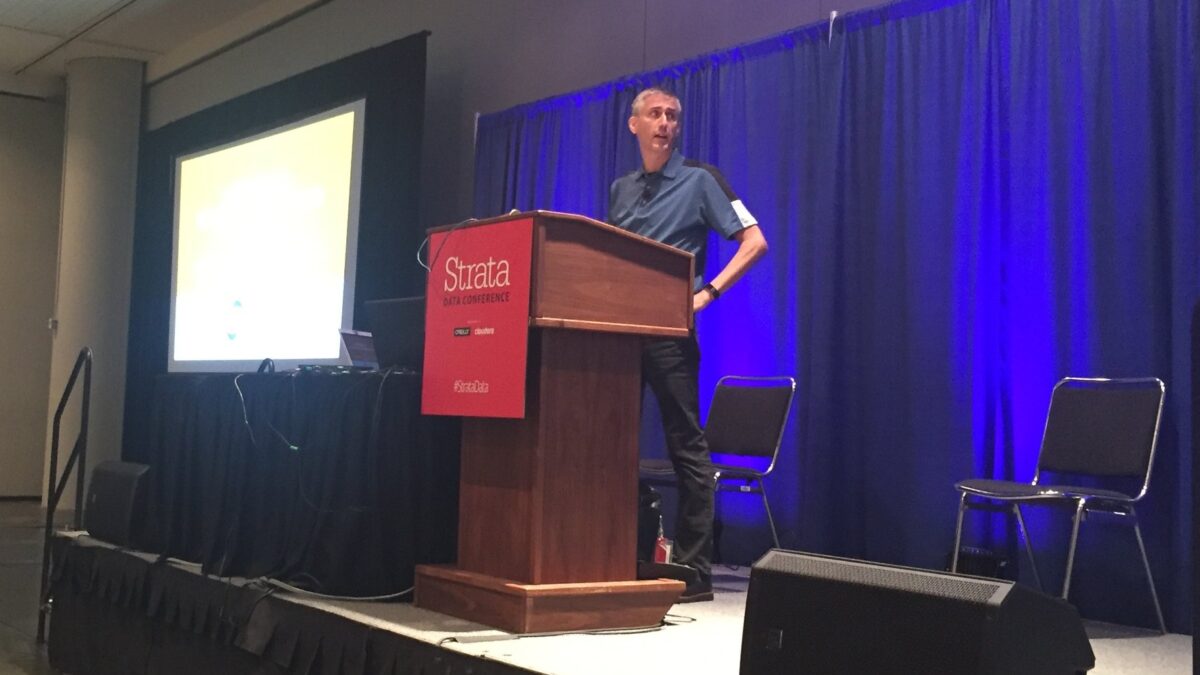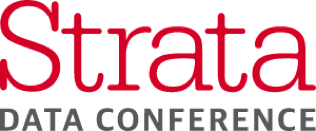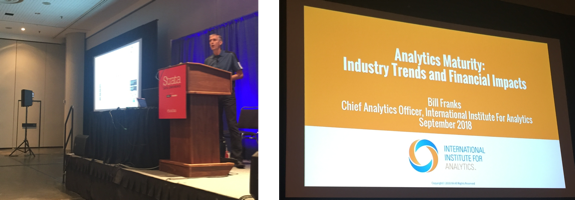

Last week, IIA attended the O’Reilly Strata Data Conference (@StrataData) in New York City. The conference tagline was “Make Data Work” and it provided a comprehensive overview of continued innovation in the big data and analytics ecosystems.
Session topics ranged from technical discussions on specific data, analytics and AI technologies to more general team management and business strategy. The conference continued to feature a dedicated series of business sessions organized into the Strata Business Summit and dedicated full day track covering the financial services industry called Findata Day.
IIA’s Bill Franks was one of the featured speakers for the Strata Business Summit. His presentationAnalytics Maturity: Industry Trends and Financial Impacts featured IIA’s original analytics maturity and company performance research.

The Wednesday (9/12/18) and Thursday (9/13/18) morning keynotes showcased a variety of thought leaders covering a wide range of topics including the following top 7 highlights:
In his keynote Preserving Privacy and Security in Machine Learning, Ben Lorica (Chief Data Scientist, O’Reilly Media, @BigData) provided an overview of several important considerations for machine learning including fairness, transparency, privacy and security. Ben discussed market research indicating that privacy and fairness considerations for ML models are growing in importance. He then provided an overview of some of the techniques being developed to address these issues including differential privacy, specialized encryption, anti-classification, classification parity and calibration. Ben ended is keynote by advocating the need for ML “validators” that would have the data, domain, compliance and security background to manage the potential risks.
Amber Case (MIT Media Lab, @caseorganic) discussed the importance of sound in her keynote Calm Technology, Design for the Next Generation of Devices. Amber notes that humans cannot turn off their ears and that out attention is an increasingly limited resource. Sound is one of the most commonly overlooked components in product design. To emphasize her point, she quotes a study that showed experienced nurses take longer to respond to alerts than inexperienced nurses due to the overwhelming number of noise producing devices. Over time, people become desensitized to it. She advocates for “calm technology” that considers sound, as well as visualization, in product design. Considers for “calm technology” include using better speaker technology, better information embedded in sound, sound removal and the ability to turn sound off.
In his keynote Black Box: How AI will Amplify the Best and Worst of Humanity, Jacob Ward (CNN / Al Jazeera / PBS, @_jacobward, website) discussed how humans generally don’t understand probability and make decisions using a rules and shortcuts that can impact how analytics are actually used. For example, he cited research showing the humans tend to correctly interpret only five probabilities - 0%, 1%, 50%, 99% and 100% - and that other behaviors such as representativeness (“I know this type”), availability (“This happens all of the time in the news”) and anchoring (“This feels like a bargain” based on opening price) are systematic mistakes humans tend to make. To ensure that AI corrects our bad behaviors (versus amplify them), Jacob proposes “Glass Box” principles for AI design. These principles include DARPA’s “Explainable AI” Program, creation of ethics frameworks and “literacy” training for growing up with AI.
Joseph Lubin (@ethereumJoseph), a cofounder of blockchain computing platform Ethereum and the founder of blockchain venture studio Consensus Systems, discussed Trust 3.0 and how “we’re moving from subjective, manual trust systems to automated, guaranteed trust systems” such as Ethereum. Joseph claims that traditional models of identity are broken, and that decentralization is the answer.
Dinesh Nirmal (VP Development, IBM Analytics, @dineshknirmal) demonstrated how machine learning, NLP and AI can help companies manage increasing amounts of regulation in his presentation Wait … Pizza is a Vegtable? Decoding Regulations Using Machine Learning.
Julia Angwin (@JuliaAngwin, website) explored how algorithms used to make important decisions such as who gets out of prison and auto insurance premiums often display bias and forgiveness in her keynote Quantifying Forgiveness. Julia presented a comparison of predictions from an algorithm uses to predict recidivism versus actual crimes committed. The research looked at 18,000 cases and found that black defendants were 45% more likely to be assigned a higher risk score than white defendants.
Hilary Mason (GM for Machine Learning, Cloudera, @hmason, website) discussed the continued evolution of AI and ML in her keynote Practical ML Today and Tomorrow. Hillary notes that organizations building ML and AI capabilities must scale in security, governance, compliance and organizational processes. They should also manage their capabilities with a portfolio investment model (versus a purchase) and build end-to-end infrastructure with three key capabilities: 1.) An “opportunity discovery” process to discover and prioritize opportunities for ML and AI. 2.) An “AI factory” built on an agile platform to build, train and deploy ML applications and 3.) A “business transformation” capability to absorb business transformation and discover the next opportunity.
Vendors continue to build out infrastructure and services for enterprise analytics and AI adoption and Google, Intel, MapR, Cisco, MemSQL and Cloudera all gave keynote presentations highlighting some of their latest offerings. Three new vendors were featured in the first Strata Data Awards which were given in three categories: Most Disruptive Startup (TigerGraph), Most Innovative Product (Dow Jones DNA) and Most Impactful Initiative (Vertica). TigerGraph is “a fast graph analytics platform designed to unleash the power of interconnected data for deeper insights and better outcomes.” Dow Jones DNA is a “Data-as-a-Service platform providing access to fully licensed news and derived data to support data scientists and application developers in their advanced analytics and workflow initiatives.” Vertica provides a “unified analytical database that supports all major cloud platforms, all popular data formats and features advancements in in-database Machine Learning.”
As the pace of big data, analytics and AI innovation continues to accelerate, analytics leaders must look outside their organizations to track developments in these technologies and to understand how these developments may impact their organizations and the customers they serve. Conferences like the O’Reilly Strata Data Conference are excellent sources of insight as they bring together all of the key constituents of the big data, analytics and AI communities. IIA will also continue its ongoing coverage of these important conferences with client-only phone briefings and event summaries.